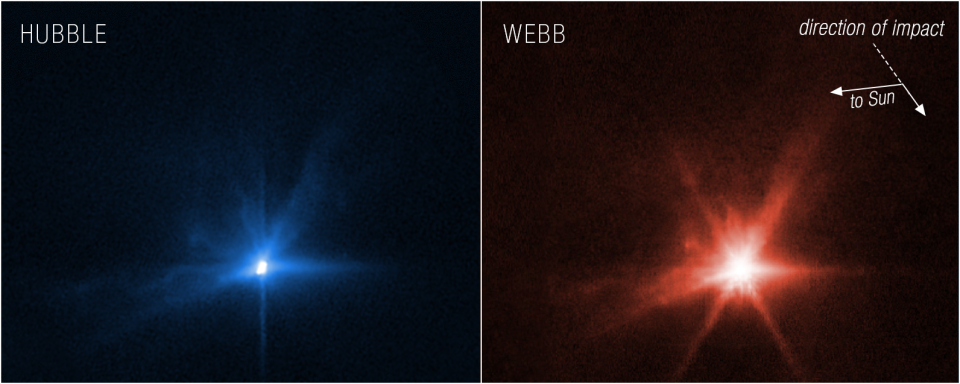When NASA successfully crashed into an asteroid, these famous telescopes captured the effects
NASA's DART mission of crashing into an asteroid was a success, but viewers were unable to see the aftermath of the impact because the last thing the spacecraft saw was an extreme close up of the asteroid, Dimorphos.
Luckily, two famous telescopes witnessed the event and captured the aftermath of the historic collision, as NASA says the James Webb Space Telescope and the Hubble Space Telescope did their first ever observations of the same celestial target Monday evening.
"For the first time, Webb and Hubble have simultaneously captured imagery from the same target in the cosmos: an asteroid that was impacted by a spacecraft after a seven-million-mile journey," NASA Administrator Bill Nelson said in a statement. "Webb and Hubble show what we’ve always known to be true at NASA: We learn more when we work together."

The James Webb Telescope has taken several dazzling photos of our solar system and universe with its near-infrared camera, but trying to capture Dimorphos was a challenge because of its speed across space. The team working on the telescope was able give it a better tracking method to capture the asteroid.
The telescope was able to take observations before the collision and several shots afterwards, showing "plumes of material" streaming away from the center of the asteroid.
Speed, I am speed.
Observing the #DARTMission impact with Webb was a unique challenge. The target moved over at a speed over 3 times faster than the original speed limit Webb was designed to track! In the weeks leading up to the impact, teams carefully tested for success. pic.twitter.com/XGpTsMg0Ab— NASA Webb Telescope (@NASAWebb) September 29, 2022
The Hubble Space Telescope was also able to capture the asteroid before the impact, and then 15 minutes after the collision. In the images, ejecta from the impact can be seen stretching out as rays from the asteroid. The telescope took images eight hours after the event, and astronomers said the Dimorphos appeared three times brighter.
"When I saw the data, I was literally speechless, stunned by the amazing detail of the ejecta that Hubble captured," said Jian-Yang Li of the Planetary Science Institute in Tucson, Arizona, which leads the telescope's observations. "I feel lucky to witness this moment and be part of the team that made this happen."
Check out Hubble’s “after” shots from #DARTMission impact!
Earlier this week, @NASA intentionally crashed a spacecraft into Dimorphos, a non-threatening asteroid moonlet in the double-asteroid system of Didymos, in a test of planetary defense: https://t.co/pe2qeFDYoS pic.twitter.com/VQ5X1pQlEy— Hubble (@NASAHubble) September 29, 2022
Understanding DART: Learn about NASA's test to save Earth from future threats
Look: New images from the James Webb Space Telescope look deep into universe
Both of the telescopes will continue to monitor the asteroid; the James Webb Space Telescope will observe the asteroid system in the coming months, while Hubble will observe the asteroid 10 times in the next three weeks.
Together, NASA says the follow-ups will give the agency a better understand of Dimorphos' surface, how much of its material was ejected and how fast it happened. All of it will aid NASA's planetary defense plans, as astronomers say it will likely take months to understand the full effect of the DART mission.
"All of humanity eagerly awaits the discoveries to come from Webb, Hubble, and our ground-based telescopes – about the DART mission and beyond," Nelson said.
Follow Jordan Mendoza on Twitter: @jordan_mendoza5.
More: 'Bones' of spiral galaxy captured in new image from NASA's James Webb Space Telescope
What's everyone talking about? Sign up for our trending newsletter to get the latest news of the day
This article originally appeared on USA TODAY: James Webb, Hubble Telescopes capture asteroid hit by NASA's DART

